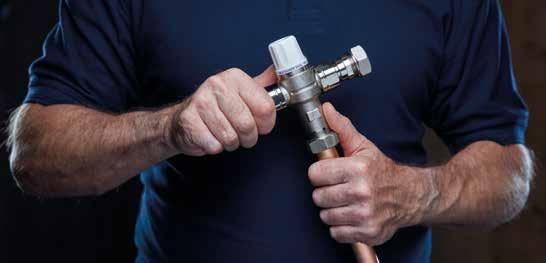
3 minute read
The hot case for TMVs
Thermostatic mixing valves have become an integral feature of modern plumbing systems but they can also contribute to a smarter, more cost-effective environment, says RWC director of product development Eric Winter.
We’re all looking for technologies that really help to make a difference as the world tackles climate change and the energy crisis. Now it’s time to recognise the vital role that TMVs play in driving safety, savings and sustainability in buildings.
By mixing hot and cold water to deliver a consistent and pre-determined temperature, TMVs provide two vital safety functions: they help prevent scalding and, by enabling hot water systems to run at sufficiently high temperatures, they help protect against the build-up of Legionella bacteria in the pipework.
TMVs are a necessity in all commercial and domestic new-builds, properties undergoing a change of use and in hospitals, care homes and other healthcare environments. In other words, pretty much everywhere.
There are two levels of certification: TMV2 (domestic and commercial) and TMV3 (healthcare). The performance difference between them is essentially the speed and accuracy of operation and the application they are used in. For exact nature of the application and many have added features such as isolators, test ports, and an anti-tamper cap.
Making hot water go further
For gyms, healthcare settings, and multi-occupancy dwellings where large numbers of people bathe and shower, saving energy is particularly important. BMJ research suggests that most NHS hospitals are braced for huge rises in their energy bills, and the uncertainty around energy costs
Enabling it to mix with the cold supply has a number of benefits. It means water can be stored at high temperatures and then blended down to 55°C or 60°C as it enters the distribution system, increasing the amount of available hot water (compared with the tank capacity). Literally, it makes hot water go further.
The addition of TBVs helps to maintain a constant temperature in the hot water system, which enhances the efficiency of TMVs. This means that larger buildings can maintain optimum output levels.
The renewable question
specified alongside solar panels will need to be able to withstand these extreme temperatures without compromising their functionality.
Of course, to optimise efficiency you should match the right valve for the application. Under-sizing can lead to pressure drops, starved outlets and inefficient flow. On the other hand, over-specification can produce unnecessarily high flow rates, leading to water waste (and unwanted noise) if there are fewer outlets than the valve is designed to serve. To ensure the right application, simply check the technical data.
example, while a TMV2 can serve multiple outlets such as sinks in a gym, TMV3 applications recommend one valve for each outlet. In most non-domestic buildings, TMV2s are tested annually, while TMV3s must be tested at least every six months after passing their initial test following installation.
TMVs must comply with a broad range of regulations and standards, including those specific to the NHS. The choice of valve clearly depends on the rising indefinitely only puts more pressure on facility managers.
To take just two examples, Nottingham University Hospitals NHS Trust is budgeting for a 200 per cent-plus increase in 2023, while Leeds Teaching Hospitals NHS Trust expects to be paying £2 million extra a month for electricity and gas.
TMVs can be used to help reduce the burden, for example by installing a thermal balancing valve (TBV) or tempering valve at the point of hot water generation.
TMVs are designed to work best with water at a temperature of about 65°C-85°C, which makes them suitable for renewable systems in combination with solar panels or heat pumps. However, there are important factors to bear in mind from a specification point of view.
Heat pumps run at lower temperatures than conventional boilers, and special attention needs to be paid when specifying TMVs to be used in combination with a heat pump. It is important to remember that some renewable energy resources run at much higher temperatures than conventional energy resources, often reaching 90°C. TMVs
Sufficient hot water: sustainably
TMVs were initially developed to help enhance system and personal safety but their capabilities extend beyond simply that. They have value in terms of efficiency and energy saving. These qualities can be amplified even further by combining them with other valves to deliver sufficient hot water sustainably.
They may not be the sole answer to the pressing climate and energy crises we’re facing, but as part of any forwardthinking plumbing system, they’re definitely part of the solution. ■ reliancevalves.com




